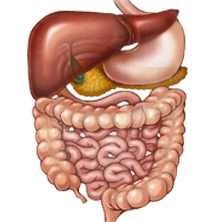Queiroz TB, Santos GF, Ventura SC, Hiruma-Lima CA, Gaivão IOM, Maistro EL Genetics and Molecular Research, 2017 ABSTRACT: Geraniol is an acyclic monoterpene alcohol present in the essential oil of many aromatic plants and is one of the most frequently used molecules by the flavor and fragrance industries. The literature also reports its therapeutic potential, highlighting itself… Read more »

This system includes the mouth, teeth, tongue, esophagus, stomach, small intestine, pancreas, gallbladder, liver, large intestine, rectum and anus. Common disorders include GERD (acid reflux), indigestion, gut motility disorders, ulcerative colitis, Crohn’s disease and peptic or duodenal ulcers.
Inhibitory effects of cinnamon and clove essential oils on mold growth on baked foods
Ju J, Xu X, Xie Y, Guo Y, Cheng Y, Qian H, Yao W Food Chemistry, 2017 ABSTRACT: This study evaluated the minimum inhibition concentration (MIC) and minimum lethal concentration (MLC) of cinnamon and clove essential oils against mold growth on green bean cake and finger citron crisp cake, and also examined the effects of these two essential… Read more »
Biological Activities of Three Essential Oils of the Lamiaceae Family
Nieto G Medicines (Basel), 2017 ABSTRACT: Herbs and spices have been used since ancient times to improve the sensory characteristics of food, to act as preservatives and for their nutritional and healthy properties. Herbs and spices are generally recognized as safe (GRAS) and are excellent substitutes for chemical additives. Essential oils are mixtures of volatile compounds obtained,… Read more »
Essential Oils’ Chemical Characterization and Investigation of Some Biological Activities: A Critical Review
Dhifi W, Bellili S, Jazi S, Bahloul N, Mnif W Medicines (Basel), 2017 ABSTRACT: This review covers literature data summarizing, on one hand, the chemistry of essential oils and, on the other hand, their most important activities. Essential oils, which are complex mixtures of volatile compounds particularly abundant in aromatic plants, are mainly composed of terpenes biogenerated… Read more »
Rosemary (Rosmarinus officinalis) essential oil components exhibit anti-hyperglycemic, anti-hyperlipidemic and antioxidant effects in experimental diabetes
Selmi S, Rtibi K, Grami D, Sebai H, Marzouki L Pathophysiology, 2017 INTRODUCTION: The present study aims to investigate the protective effects of Rosemary (Rosmarinus officinalis L.) essential oils (ROEO) against alloxan-induced diabetes and oxidative stress in rats. METHODS: The animals were divided into four groups: Healthy Control (HC); Diabetic Control (DC); Healthy+ROEO (H+ROEO) and Diabetic+ROEO (D+ROEO)…. Read more »
Hepatotoxicity of monoterpenes and sesquiterpenes
Zárybnický T, Boušová I, Ambrož M, Skálová L Archives of Toxicology, 2017 ABSTRACT: Public interest in natural therapies has increased significantly over past decades. Herbs and herbal products are extensively consumed worldwide and they are generally considered as safe. However, this may not always be true as many cases of herb-induced liver injury are reported… Read more »
Anti-Inflammatory and Antioxidant Actions of Copaiba Oil Are Related to Liver Cell Modifications in Arthritic Rats
Castro Ghizoni CV, Arssufi Ames AP, Lameira OA, Bersani Amado CA, Sá Nakanishi AB, Bracht L, Marçal Natali MR, Peralta RM, Bracht A, Comar JF Journal of Cellular Biochemistry, 2017 ABSTRACT: The present study investigated the action of copaiba oil (Copaifera reticulata) on the systemic inflammation, oxidative status, and liver cell metabolism of rats with adjuvant-induced arthritis…. Read more »
As an Adjunct to Mechanical Oral Hygiene, Essential Oil-containing Mouthwash, Compared to Floss, Cetylpryidinium Chloride, or Placebo may be more Effective in Reduction of Plaque and Gingitivitis
Tilliss T, Carey CM Journal of Evidence Based Dental Practice, 2017 ABSTRACT: The question being studied by this systematic review of the literature is how mouthwashes containing essential oils used as adjuncts to daily mechanical plaque control compare to placebo mouthwashes, cetylpyridinium chloride (CPC), or dental floss in reducing plaque and gingivitis among adults with gingivitis…. Read more »
In Vitro Efficacy of Essential Oil Mouthrinse versus Dentifrices
Serbiak B, Fourre T, Geonnotti AR, Gambogi RJ Journal of Dentistry, 2017 OBJECTIVES: To compare the antimicrobial efficacy and kill penetration of essential oils (EO) mouthrinse versus stannous fluoride, and triclosan dentifrice slurries on saliva-derived biofilms using confocal laser scanning microscopy (CLSM). METHODS: Saliva-derived biofilms were grown for 48hours on hydroxyapatite discs using pooled, homogenized… Read more »
A Review on Influencing Factors on the Minimum Inhibitory Concentration of Essential Oils
Van de Vel E, Sampers I, Raes K Critical Reviews in Food Science and Nutrition, 2017 ABSTRACT: With growing interest in essential oils as natural preservatives in the food industry, the literature is expanding enormously. To understand the antimicrobial activity of essential oils, the antimicrobial mechanism of individual essential oil (EO) compounds, and their minimum inhibitory concentrations… Read more »
